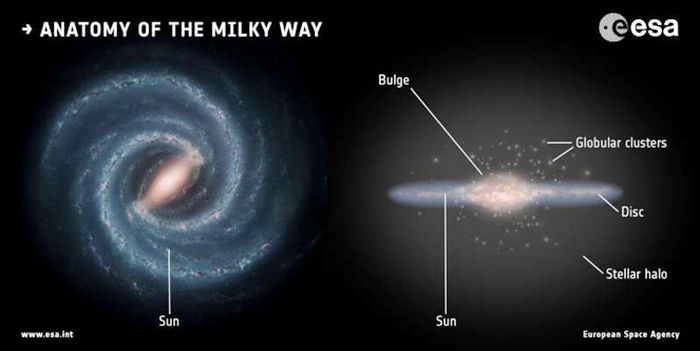Stefan Payne-Wardenaar / MPIA
–
The basic structure of our home galaxy, edge view. New results from ESA’s Gaia mission provide a reconstruction of the history of the Milky Way, specifically the evolution of the so-called thick disk.
–
Nationalgeographic.co.id – Using data from ESA’s Gaia mission, astronomers have shown that part of the Milky Way known as the ‘thick disk’ began to form 13 billion years ago, about 2 billion years earlier than thought, and only 0.8 billion years after Big Bang.
This surprising result comes from an analysis conducted by Maosheng Xiang and Hans-Walter Rix, of the Max-Planck Institute for Astronomy, Heidelberg, Germany. They fetch brightness and position data from the dataset Early Data Release 3 (EDR3) Gaia and combine it with measurements of the chemical composition of stars, as provided by data from Large Sky Area Multi-Object Fiber Spectroscopic Telescope (LAMOST) with about 250,000 stars to get their age.
They chose to see a giant sub star. In these stars, energy has stopped being generated in the core of the star and has moved to the skin around the core. The star itself is transformed into a red giant star. Since the subgiant phase is a relatively short evolutionary phase in a star’s life, it is possible to determine its age with great accuracy, but is still a complex calculation.
The age of a star is one of the most difficult parameters to determine. It cannot be measured directly but must be inferred by comparing the characteristics of stars through computer models of stellar evolution. Composition data helps with this. The Universe was born with almost exclusively hydrogen and helium. Other chemical elements, collectively known as metals by astronomers, are made inside stars, and explode back into space at the end of a star’s life, where they can be incorporated into the next generation of stars. So, older stars have less metal and are said to have lower metal levels.
The LAMOST data gives metallic properties. Together, the brightness and metallic properties allow astronomers to extract the age of the star from computer models. Prior to Gaia, astronomers routinely worked with 20 to 40 percent uncertainty, which could result in an incorrect age being determined to be a billion years or more.
“With Gaia’s brightness data, we can determine the age of a sub-giant star by a few percent,” Maosheng said, as reported Tech Explorist. Armed with the exact age for a quarter of a million subgiant stars scattered all over galaxyMaosheng and Hans-Walter began the analysis.

European Space Agency
–
Illustration of our Milky Way galaxy, a 13 billion year old ‘barked spiral galaxy’ that is home to several hundred billion stars. On the left, the front view shows the spiral structure of the Galactic Disk. On the right, the edge view shows a flat disc shape.
–
The Milky Way is made up of various components which are classified as halos and discs. The halo is considered to be the oldest component of the galaxy, while the thin disk contains most of the stars we see as the misty band of light in the night sky that we call the Milky Way.
Scientists can build a timeline for the formation of the Milky Way by identifying the giant stars in these different regions. And that’s when they got a surprise.
Also Read: Most Energetic, Fast Radio Blast of the Milky Way on Record
PROMOTED CONTENT
Featured Videos
–


